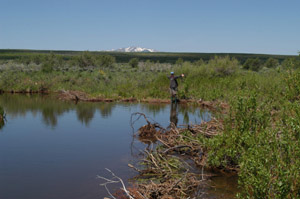Hilary Cooke
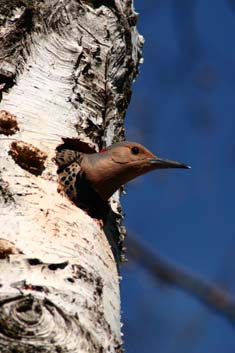 |
Hilary CookeEcology of the cavity-using community in mixedwood boreal
forest
|
|
Ph.D. Research The functional relationships among the species creating and using cavities, and the flow of the cavity resource through the community, has been described as a nest web, a novel approach to studying communities based in food web theory (see Martin and Eadie 1999 Forest Eco & Man 115:243). In the interior coniferous forests of central B.C., Martin et al. (2004) found support for this bottom-up model of community organization, with the cavity resource flowing up from the primary excavators to a diverse group of secondary nesters. Northern Flickers were identified as a keystone excavator, creating the majority of cavities used by secondary nesters. Given differences in forest structure, and the composition of the cavity-using community, it is likely that the cavity nest web for old mixedwood boreal systems differs from that described for interior B.C. Old mixedwood boreal forest stands (>100 yrs) are characterized by
high densities of large trees, snags, and trees infected with heartrot
fungi. Consequently, there is a richer and more abundant community of
cavity Impacts of clearcut timber harvest have prompted forestry companies to
adopt a "natural disturbance model" (NDM), which attempts to
approximate fire and fire skips by harvesting larger areas and leaving
larger patches of trees and snags. Under this approach, harvest effects
may be ameliorated if retained patches act as "lifeboats", supporting
the primary excavators and secondary users, and the functional relationships
among them, found in old forest cavity communities. The relative value
of retained forest patches to act as "lifeboats" may depend
on the size, shape, and structure of retained patches. My research objectives are 1) to describe the cavity nest web for oldmixedwood boreal forest and to identify keystone excavators; 2) to determine the value of retained forest patches as "lifeboats" for maintaining functional relationships among cavity users by describing the nest web for NDM harvested landscapes and contrasting it with the nest web for intact forest landscapes; and, 3) to characterize key features of occupied cavity trees, and the local habitat and landscape structure surrounding them. Photos by C. Kolacz. Professional Background My field research experiences include studying Neotropical migrant songbirds and habitat fragmentation with the University of Guelph, and Bald Eagles and landbirds with the Point Reyes Bird Observatory (Stinson Beach, California). Before coming to the University of Alberta, I worked for five years with
the Wildlife
Conservation Society studying riparian birds in arid regions of California,
Oregon, and Wyoming. My research focused on responses of songbirds to
riparian restoration accomplished through alternative grazing My extra-curricular activities at the University of Alberta include the
Biology Graduate Student
Association Executive and cofounder of the Ecology Graduate Student
Seminar Series.
|
|
|
Last Modified:2004-11-29 |
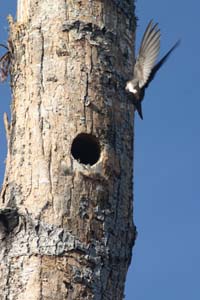 Aspen with heartwood decay (caused primarily by the fungus Phellinus
tremulae) and others (e.g. Northern Flickers) preferring already dead
and decaying trees (snags). Chickadees and Nuthatches are described as
weak excavators because they will reuse woodpecker holes or excavate their
own cavity in soft, decaying snags. Secondary users (including Tree Swallows,
Mountain Bluebirds, American Kestrels, Bufflehead, Common Goldeneye, Red
Squirrels, owls, and bats) cannot excavate their own cavity. These species
are limited by the availability of cavities formed naturally (e.g. by
splits in tree trunks or the tops of broken-top trees) or cavities excavated
by woodpeckers.
Aspen with heartwood decay (caused primarily by the fungus Phellinus
tremulae) and others (e.g. Northern Flickers) preferring already dead
and decaying trees (snags). Chickadees and Nuthatches are described as
weak excavators because they will reuse woodpecker holes or excavate their
own cavity in soft, decaying snags. Secondary users (including Tree Swallows,
Mountain Bluebirds, American Kestrels, Bufflehead, Common Goldeneye, Red
Squirrels, owls, and bats) cannot excavate their own cavity. These species
are limited by the availability of cavities formed naturally (e.g. by
splits in tree trunks or the tops of broken-top trees) or cavities excavated
by woodpeckers.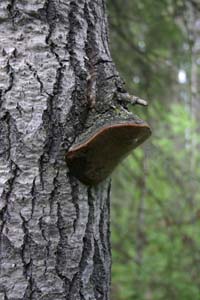 nesters
in old stands compared with young forest stands. The prevalence of old
forest habitat will decrease across the landscape as forestry practices
aim to minimize loss due to death and decay through short harvest rotation
periods (~80 yrs). By decreasing the availability of old forest habitat,
creating forest openings and edges, and increasing early successional
habitat, timber harvest may modify the cavity nest web structure. Shifts
in composition and densities of excavators may have cascading effects
up through the nest web, affecting secondary nesters in turn, and thus
changing functional relationships among cavity users.
nesters
in old stands compared with young forest stands. The prevalence of old
forest habitat will decrease across the landscape as forestry practices
aim to minimize loss due to death and decay through short harvest rotation
periods (~80 yrs). By decreasing the availability of old forest habitat,
creating forest openings and edges, and increasing early successional
habitat, timber harvest may modify the cavity nest web structure. Shifts
in composition and densities of excavators may have cascading effects
up through the nest web, affecting secondary nesters in turn, and thus
changing functional relationships among cavity users.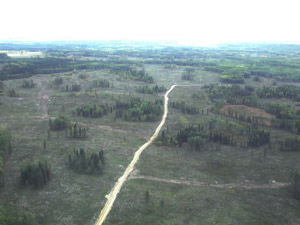
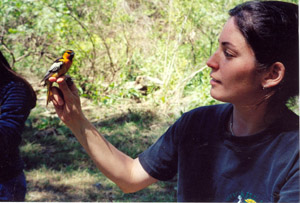 practices and beaver reintroductions. I worked with private and public
land managers to understand how birds responded to their management efforts,
to identify key habitat needs of riparian obligate species, and to identify
riparian bird indicator species.
practices and beaver reintroductions. I worked with private and public
land managers to understand how birds responded to their management efforts,
to identify key habitat needs of riparian obligate species, and to identify
riparian bird indicator species.